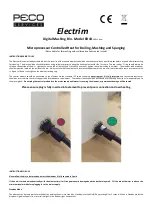
70S_Rev1
2
Safety Information
WARNINGS!
Disconnect the AC power cord from the AC adapter inlet or the wall socket (outlet)
immediately if user observes the following or if the splicer receives the following faults:
• Fumes, bad smell, noise, or over-heat occurs.
• Liquid or foreign matter falls into cabinet.
• Splicer is damaged or dropped.
If this occurs, ask our service center for repair. Leaving the splicer in a damaged state
may cause equipment failure, electric shock or fire and may result in personal injury,
death or fire.
AC adapter which be used for a splicer is only an adapter for exclusive use.
Using an improper AC power source may cause fuming, electric shock or equipment
damage and may result in personal injury, death or fire.
Use the supplied AC power cord. Do not place heavy objects on the AC power cord.
Use of an improper cord or a damaged cord may cause fuming, electric shock or
equipment damage and may result in personal injury, death or fire.
Do not disassemble or modify the splicer, AC adapter or battery. In particular, do not
remove or bypass any electrical or mechanical device (e.g. a fuse or safety switch)
incorporated into the design and manufacturing of this equipment. Modification could
cause damage that may result in personal injury, death, electric shock or fire.
Never operate the splicer in an environment where flammable liquids or vapors exist.
Risk of dangerous fire or explosion could result from the splicer’s electrical arc in such
an environment.
Do not use compressed gas or canned air to clean the splicer. They may contain
flammable materials that could ignite during the electrical discharge.
Do not touch the electrodes when the splicer is on and power is supplied to the unit.
The electrodes generate high voltage and high temperatures that may cause a severe
shock or burn.
Note Arc discharge stops when wind-protector is opened.
Turn the splicer off and
disconnect the AC power cord before replacing electrodes.
Safety glasses should always be worn during fiber preparation and splicing operation.
Fiber fragments can be extremely dangerous if it comes into contact with the eye, skin,
or is ingested.







































